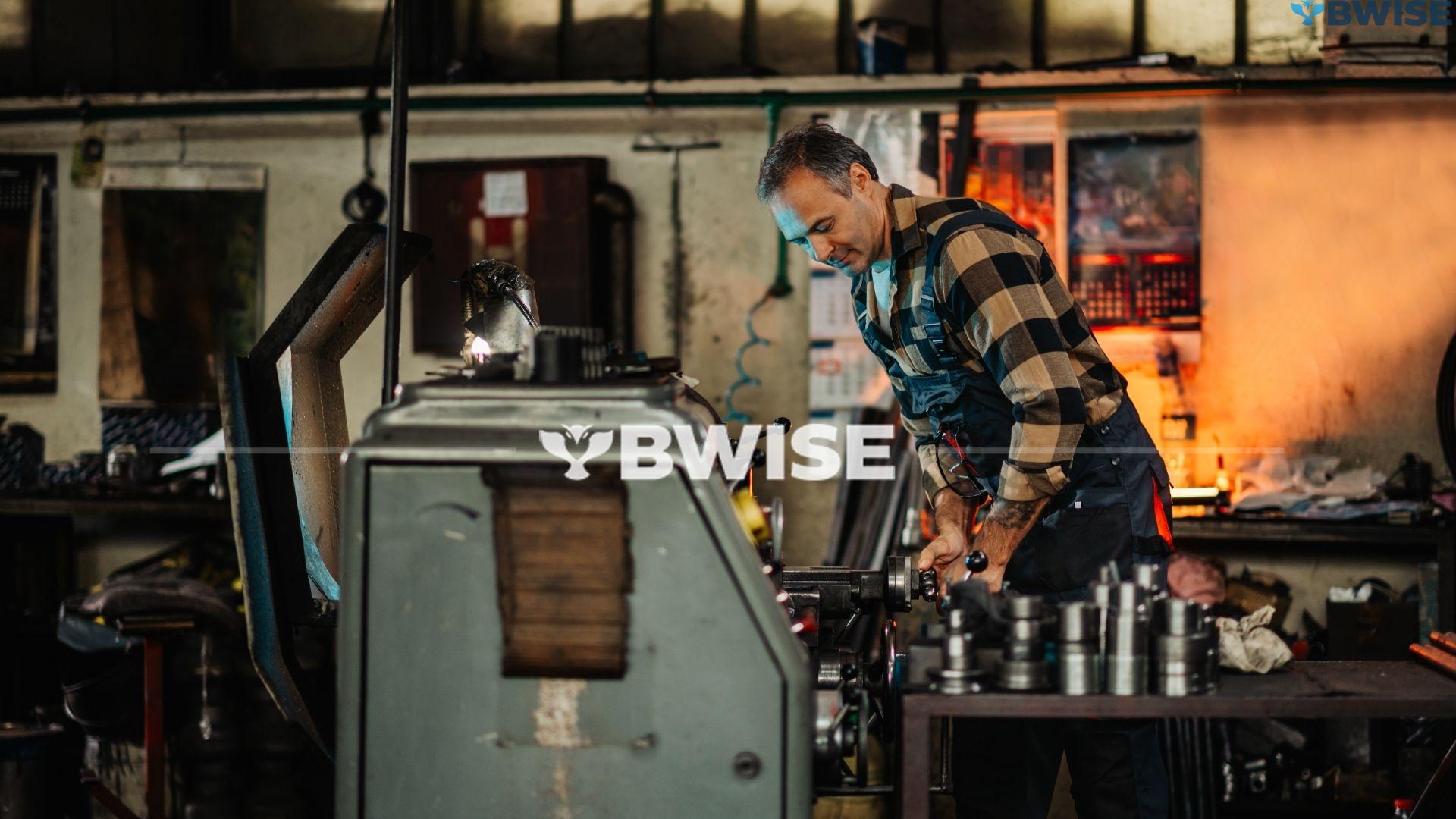Businesses today need to adapt quickly. One method to keep pace is the adoption of lean manufacturing principles. This mindset yields greater efficiency, nimbleness, and an intense customer focus. It is a proven path to compelling business outcomes.
Lean manufacturing focuses on reducing waste to continually improve. It is about identifying and eliminating what is not beneficial. This boosts company efficiency and competitiveness. Through a dedicated emphasis on waste reduction and consistent improvement, lean organizations deliver superior products and services to customers.

Lean manufacturing fosters an atmosphere where team spirit and collaborative problem-solving shine. It empowers staff, encouraging them to spot and rectify less efficient approaches. This action sparks a wave of creativity and fast-tracked enhancements in procedures. Thus, keeping businesses one step ahead in the competitive market.
Lean manufacturing is key for keeping an edge. It centers on reducing waste, continually improving, and zeroing in on customer needs. This method bolsters businesses to expand, remain robust, and be industry leaders.
Key Takeaways
- Lean manufacturing focuses on cutting waste, getting better, and putting customers first.
- Using lean practices makes processes smoother, uses resources better, and boosts competitiveness.
- Lean manufacturing encourages teamwork and solving problems together, leading to innovative ideas and better processes.
- Adopting lean principles brings big innovation and long-term success for companies.
- Lean manufacturing puts the customer at the center to drive growth and stay ahead.
Introduction to Lean Manufacturing Principles
Lean manufacturing is fresh and unique. It aims to boost value for customers and reduce waste. Born from the Toyota Production System, it’s reshaped global industries. Lean thinking? It is about constant improvement, waste elimination, and customer prioritization.
What is Lean Manufacturing?
Lean manufacturing helps things work better by tossing out waste. This method spots every type of waste, such as time, materials, and effort, and aims to toss them out. By streamlining operations, lean manufacturing assists businesses in improving their goods and services quicker.
Origins and Evolution of Lean Thinking
Toyota kick-started the concept of lean production in the 1950s, known as the Toyota Production System (TPS). Seeing American supermarkets’ efficiency and quality sparked them to develop the just-in-time (JIT) process and constant improvement, also known as Kaizen. These lean principles gradually expanded across numerous sectors, establishing a norm for effective work today.
Waste Elimination: The Core of Lean Principles
Lean manufacturing aims to eliminate waste. It targets seven primary waste types: overproduction, waiting, transportation, over-processing, inventory, motion, and defects. Removing these unhelpful tasks enables businesses to optimize their operations, improve their performance, and offer higher value to their customers.
Lean focuses on the belief that if it doesn’t benefit the customer, it is a waste. This unnecessary activity slows progress and gobbles resources, which hikes up expenses and dwindles customer satisfaction. With a lean mindset, businesses can unearth fresh strategies to improve, ignite creativity, and win more.
Mastering waste elimination is essential for streamlined production. You need to recognize various waste forms and understand how to identify and eliminate them during manufacturing. Adopting such a mindset on waste aids businesses in staying competitive while providing enhanced value to their clients.
Continuous Improvement: Kaizen Philosophy
The principle of Kaizen is fundamental to streamlined production. It promotes daily improvements. Workers at all tiers can spot and address issues. This cultivates an environment ripe for invention and collaboration.

Implementing Kaizen in the Workplace
First off, using Kaizen boils down to ensuring workers feel personally invested in it. Bosses need to show that ongoing enhancement, tackling dilemmas, and keeping staff involved matter a lot. This involves providing folks with the necessary gear, schooling, and commendation to excel.
This method gets employees pumped to spot and solve issues. It boosts the business in numerous aspects, such as increasing production, enhancing work quality, and pleasing clients.
In Kaizen, teamwork is essential. By bringing together diverse teams, businesses uncover fresh solutions. Such teamwork improves processes and boosts employee engagement and unity.
Just-in-Time (JIT) Production
Think of just-in-time (JIT) production like a well-oiled machine in the world of manufacturing. It is a lean principle transforming business operations. It is all about creating the perfect product, in the exact quantity, exactly when customers demand it. This method reduces stockpiles, shrinks waiting periods, and ramps up productivity.
Benefits of JIT Manufacturing
JIT production definitely has some advantages. Firstly, it helps slash costs as heavy inventories are not required. That translates to lesser expenses for storage and managing inventory. Furthermore, businesses can adapt more rapidly to the fluctuating markets and the demands of the customers by employing JIT.
A major advantage is quick turnarounds. Companies can create products on the fly as orders pour in, speeding up delivery. This boosts customer contentment and aids companies in leading the market.
Thanks to on-demand production, lean manufacturing firms thrive. It finesses stock handling, polishes procedures, and amplifies agility. These tweaks bring substantial cost cuts, extra adaptability, and superior service. These benefits promote continuous evolution and expansion.
Pull System: Demand-Driven Production
In the realm of efficient manufacturing, the pull system revolutionizes product creation. Its priority is to produce just what the consumer requires, minimizing unnecessary output. With the help of a kanban system, it signals when to make or transport goods, ensuring a steady production flow.
This method hears the actual needs of customers, bypassing predictions. It enables businesses to be nimble and adaptable, addressing customer demands swiftly. Companies that cater to the immediate desires of customers tend to operate more smoothly, reduce their inventory, and improve efficiency.
Employing the pull system along with kanban enhances a business’s efficiency. It streamlines product flow and ensures production begins only as required, thereby reducing waste. Combining these lean methods empowers firms to excel, provide exceptional value, and pioneer in their sectors.
Value Stream Mapping: Optimizing Processes
Value stream mapping is crucial in lean manufacturing. This tool gives companies insight into their production or service process. Observing the entire procedure helps businesses identify and eliminate non-essential elements. The result? A smoother, more productive workflow.
Value stream mapping helps businesses ‘see’ their present situation and discover ways to get better. Each step of creating a product or service is scrutinized. It lets them spot areas where time or resources go down the drain. This could be relocating items, holding excess inventory, or idling.
So, they’re able to tweak and correct these problems. This increases work efficiency and creates satisfied customers. Value stream mapping is about making processes streamlined and productive, adhering to lean manufacturing concepts.
Companies benefit as it lays out the entire procedure. This allows them to refine their processes, boost productivity, and provide enhanced value to their consumers.
Lean Manufacturing Principles
Lean manufacturing aims to give customers their money’s worth. The customer’s needs come first. This view steers the lean mindset. Consistent upgrade, also known as Kaizen, prods businesses to enhance procedures, eliminate waste, and boost productivity.
Getting rid of waste is key in lean manufacturing. By removing the seven types of waste – overproduction, waiting, transportation, inventory, motion, over-processing, and defects – companies can work better. This frees up resources to give more value to customers.
At the core, lean manufacturing values its people. It believes in empowering and engaging employees to drive innovation and constant improvement. By promoting teamwork, solving problems together, and learning continuously, lean companies tap into their team’s smarts and creativity. This helps them tackle challenges and find new chances.
By following principles like focusing on customers, always improving, cutting waste, and valuing people, companies can become lean. This approach boosts productivity and profits. It also creates a culture of innovation and flexibility. This lets companies stay ahead in a fast-changing market.
Kanban: Visualizing Workflow
Kanban is a key tool in lean manufacturing that changes how companies manage their work. It uses visual signals like cards or digital boards to control work and inventory flow. This method gives a clear view of production, helping companies spot bottlenecks and keep the right inventory levels.

Advantages of Kanban Systems
Kanban systems bring many benefits to businesses. They make work transparent, letting teams see task status and production progress easily. This boosts team communication and helps us make faster decisions.
These systems also make workflows more efficient by finding and fixing bottlenecks. By seeing workflow, companies can spot slowdowns and fix them. This leads to better manufacturing efficiency, less waste, and more productivity and savings.
Also, Kanban helps businesses quickly adapt to customer needs. It matches production with demand, avoiding overproduction. This keeps inventory in check, cutting down on storage costs and waste.
Kanban systems are a full solution for managing work, improving workflows, and controlling inventory in lean manufacturing. They drive innovation and success in companies.
Gemba Walk: Going to the Actual Place
In lean manufacturing, the Gemba walk is a key tool. It helps leaders and managers see what is really going on. “Gemba” means “the actual place” in Japanese. This method stresses the need to visit the workplace to understand production.
By being part of daily work, leaders spot ways to get better, connect with their team, and learn directly. This walk is vital for lean manufacturing. It helps improve processes and keeps employees involved.
During a Gemba walk, leaders watch, ask questions, and try to grasp the issues their employees face. This hands-on method reveals hidden problems, finds waste, and suggests better ways to work. It builds a culture of ongoing improvement and keeps employees engaged, helping the company excel.
The Gemba walk is a key lean principle. It tells leaders to leave their desks and dive into the real world of their work. This approach boosts problem-solving, employee involvement, and innovation, leading to lasting success.
Poka-Yoke: Mistake-Proofing Processes
In lean manufacturing, poka-yoke is a key principle for quality improvement. It is about preventing mistakes before they happen. This ensures quality stays high in production.
Poka-yoke means adding error-proofing to processes and products. It uses sensors, guides, and physical limits to help workers avoid mistakes. This boosts product quality and makes production smoother, cutting down on waste and boosting efficiency.
Examples of Poka-Yoke Techniques
Using sensors to catch and stop errors is a common poka-yoke method. For example, a sensor can check if a part is correctly aligned before moving on. This simple step prevents misalignment and defects.
Guides and physical limits are another way to prevent mistakes. By setting up workstations with clear areas and tools, making errors almost impossible. This not only improves quality but also speeds up production by reducing the time it takes to fix errors.
By using poka-yoke, companies can raise their quality, cut waste, and keep improving. They tackle errors early, fostering a culture of excellence and innovation. This puts them ahead in the competitive manufacturing world.
Conclusion
Lean manufacturing has changed how businesses work today. It brings innovation, boosts efficiency, and leads to long-term success. By getting rid of waste, always improving, and focusing on customers, companies can make their processes better. They can also improve product quality and give more value to customers.
Companies that adopt the lean manufacturing way of thinking are ready to face today’s business challenges. This approach has shown it can make business successful and innovation happen in many industries.
The main ideas of lean thinking include Just-in-Time production, Kanban systems, and Poka-Yoke techniques. These ideas help companies make their operations better, cut waste, and make customers happier. By using these ideas, businesses can become more efficient, quick, and competitive. This puts them on a path to growth and success over time. For more information about BWISE, feel free to schedule a demo. Remember B1 – BWISE!!
